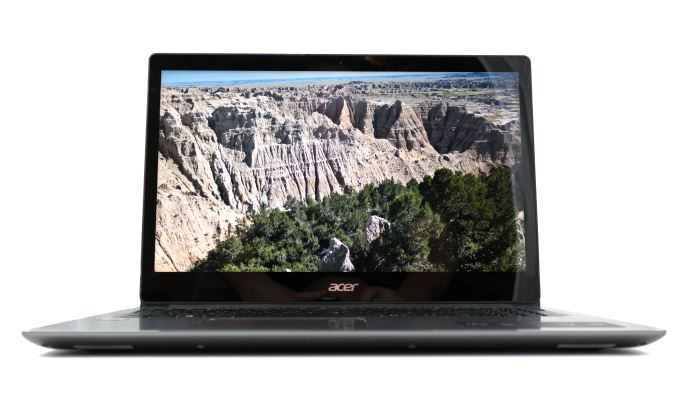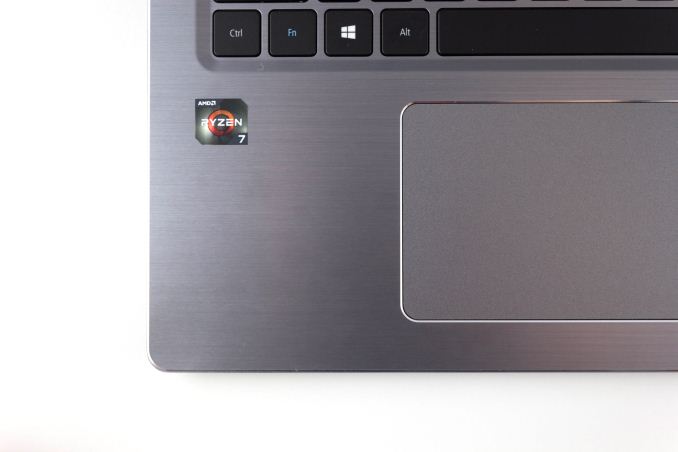The Acer Swift 3 SF315-41 Review: Ryzen Meets Laptop
by Brett Howse on May 3, 2018 8:00 AM EST- Posted in
- Laptops
- Acer
- AMD
- Ryzen
- Ryzen Mobile
- Raven Ridge

It’s been a long time since we’ve had a chance to review a laptop powered by an AMD CPU, but Acer has now launched the Acer Swift 3 powered by Ryzen Mobile, and we’ve got a chance to look at one. AMD has had a tough run in the laptop space over the last couple of years, but with the release of Ryzen in 2017, they are hoping to turn their fortunes around. But a big part of that will be having their partners package Ryzen into laptops that are of high quality, so that’s where Acer comes in.
Acer’s Swift 3 lineup is about middle of their lineup, which includes the Swift 1, 3, 5, and 7 models, and it’s a wide lineup, with Swift 3 models in both 14-inch and 15.6-inch versions, with both AMD processors with Vega graphics, as well as Intel processors, and some of those come with an optional NVIDIA GPU as well. For this review, we’ll be looking at the SF315-41-R6J9, which is a 15.6-inch version with the top-end AMD Ryzen mobile processors in the Ryzen 7 2700U.
AMD Ryzen 7 2700U is a quad-core processor with eight threads, and it has a base frequency of 2.2 GHz with a boost frequency of 3.8 GHz. It supports dual-channel DDR4-2400, and has 384 KB L1, 2 MB L2, and 4 MB L3 cache. But possibly the most exciting feature is the Radeon RX Vega 10 graphics, and in the 2700U it’s the largest GPU available with 10 GPU cores, and a boost frequency of 1300 MHz.
| Acer Swift 3 15 | |||||
| SF315-41-R8PP | SF315-41-R6J9 Model Tested |
SF315-51G-51CE | |||
| CPU | AMD Ryzen 5 2500U Quad-Core, Eight-Thread 2.0-3.6 GHz 15W TDP |
AMD Ryzen 7 2700U Quad-Core, Eight-Thread 2.2-3.8 GHz 15W TDP |
Intel Core i5-8250U Quad-Core, Eight-Thread 1.6-3.4 GHz 15W TDP |
||
| GPU | Radeon Vega 8 Compute Units Up to 1100MHz |
Radeon Vega 10 Compute Units Up to 1300MHz |
NVIDIA GeForce MX150 2 GB GDDR5 |
||
| RAM | 8 GB DDR4 | 8 GB DDR4 | 8 GB DDR4 (Standard) 16 GB DDR4 (Optional) |
||
| Storage | 256 GB SATA SSD | 512 GB SATA SSD | 256 GB SSD | ||
| Display | 15.6" 1920x1080 IPS | ||||
| Networking | 802.11ac Qualcomm QCA6174A 2x2:2 MU-MIMO Bluetooth 4.2 |
||||
| I/O | 2 x USB 3.0 1 x USB 2.0 1 x USB 3.1 Gen 1 Type-C HDMI SD Card Reader |
||||
| Battery | 48Wh, 45W AC Adapter | ||||
| Dimensions | 370 x 255 x 19.05 mm 14.59 x 10.04 x 0.74 inches |
||||
| Weight | 2.2 Kg 4.85 lbs |
2.2 Kg 4.85 lbs |
2.1 Kg 4.63 lbs |
||
| Pricing (MSRP) | $749.99 | $949.99 | $799.99 | ||
Acer’s top model of AMD based Swift 3 comes with enough connectivity in the USB-C port (Gen 1 - 5 Gbps) along with two USB 3.0 ports, and a USB 2.0 port. There’s also an HDMI output with HDCP, and a SD card reader, which is a solid amount of connections on a laptop.
While the 8 GB of RAM might seem a bit low, for this mid-range level of notebook, it’s likely enough. Acer also includes a fingerprint reader with Windows Hello support, and Wi-Fi based on the Qualcomm Atheros QCA6174A, which is a 2x2:2 802.11ac wireless NIC with MU-MIMO support and Bluetooth 4.2.
Before we take a deep dive into the performance, let’s first go over the design that Acer has created for the Swift 3.











78 Comments
View All Comments
neblogai - Friday, May 4, 2018 - link
It is not reasonable to wish an integrated GPU with ~30Gbps memory bandwidth to demolish discrete GPUs that by themselves have higher TDP than this APU, and also double or triple the memory bandwidth. Showing the same result as 940MX is a wonderful result- as AMD solution does the same with no need for extra dGPU and memory chips on the motherboard, and cooling for them. And if more GPU power is needed- then discrete GPU should be used for AMD's laptop as well- games will run great with it's fast quadcore CPU.niva - Tuesday, May 8, 2018 - link
It's very reasonable to expect an APU system to deliver better battery life, especially in idle power scenarios, than one running a core i7 with a discrete GPU. Either something is wrong with this system, they forgot to change some setting in the BIOS, or this is a complete failure on the part. The idea that this is a gaming laptop is just stupid. It's an ultra book, with better graphics capabilities than an integrated Intel chipset, but still an ultra book. I'm not even talking about performance here, I'm strictly talking battery life.Also, the idea of just adding a discrete GPU to an ultra book... never mind.
neblogai - Tuesday, May 8, 2018 - link
Discrete GPU is switched off in non-gaming, so it is basically AMD APU vs Intel APU working. It is true that Intel's chips are more efficient- after all- for many generations Intel were milking desktop with quadcores, while investing into being better at low TDP power efficiency. That is at the time when AMD was balancing on the limit of bankruptcy, and staying in survival mode till Zen arrived. So- AMD sure has a lot to improve with their design, and OEMs- with laptop designs/optimisations when using AMD APUs.As for using discrete GPU in a Ultrabook- just have a look at a ASUS Zephyrus GM501 which is 2cm thin and has a GTX1070 and other no-compromise parts. And there are at least 3 lower tier chips from nVidia alone that sip less power, making gaming on an Ultrabook possible.
samal90 - Thursday, May 3, 2018 - link
That GPU power though. I can't wait to see what next year's APUs will be like with the 7nm Navi. Intel might as well just drop the R&D for integrated graphics and license from AMD like they did with the Vega.keg504 - Thursday, May 3, 2018 - link
What is CABC?Brett Howse - Thursday, May 3, 2018 - link
Content Adaptive Backlight Control. It can change the brightness depending on what's on the screen as a way to cut power draw, but it can be kind of annoying especially when it can't be disabled.keg504 - Friday, May 4, 2018 - link
Oh, thanks.Is this a recent feature OEMs have started implementing? This is the first time I'm seeing it in a review
iwod - Thursday, May 3, 2018 - link
I think there is something wrong with Ryzen JS vm benchmarks.Ryan Smith - Thursday, May 3, 2018 - link
That's what we thought. But everything repeatedly checks out and we can find no systematic flaws. It looks like it just takes the 2700U a bit too long to respond to short, bursty workloads.iwod - Friday, May 4, 2018 - link
Interesting. Would there be a small pieces on this topic specifically?Or in other words, Intel is very aggressive with their Turbo?
Also wondering if the Adrenaline drivers made any difference.